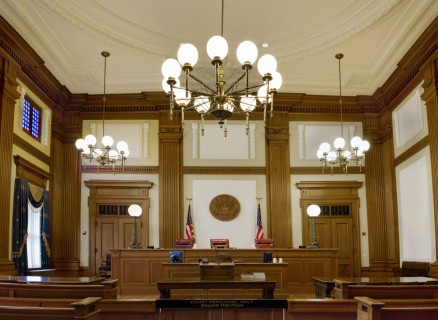
Asymmetrical deference to PTO decision-making may promote pro-patent policies.
For over two hundred years, courts have dominated patent policy. The U.S. Patent and Trademark Office (PTO) lacks robust substantive rulemaking authority and its historical adjudicatory powers, including the adjudication of patent denials, has been informal in nature. In fact, the PTO’s reviewing court, the U.S. Courts of Appeals for the Federal Circuit, has not afforded the PTO’s legal interpretations any deference, much less strong judicial deference. This, however, may be about to change.
Under United States v. Mead Corp., whether agency action is eligible for Chevron deference turns on whether Congress granted force-of-law or interpretative authority to the agency. The Mead Court stated that a delegation of rulemaking or formal adjudicatory authority is “a very good indicator” of such intent. The recently enacted America Invents Act (AIA) has granted the PTO new adjudicatory powers, including the ability to adjudicate the validity of an already issued patent in a proceeding known as post-grant review. The AIA requires post-grant review to take place in a formal, trial-like setting that Mead envisioned would warrant Chevron deference. Thus, at first blush the AIA appears to anoint the PTO as the primary interpreter of the Patent Act.
But did Congress intend the PTO to effectuate its post-grant review proceedings through formal adjudication and, if yes, was this grant of formal adjudicatory authority accompanied with a delegation of interpretative power?
The AIA, like many other statutes, uses the magic word “hearing” but not the phrase “on the record.” Although the Federal Circuit has yet to weigh in on a three-way circuit split in determining the triggering provisions of formal adjudication, applying the dominant approach—the Chevron two-step test—seems inapposite.
Imagine that the Federal Circuit applies Chevron deference to the PTO’s decision that the word “hearing” in the AIA requires the post-grant review proceedings to be effectuated through formal adjudication, and that a congressional conferral of formal adjudicatory powers is sufficient to satisfy the force-of law requirement. The implication would be that the appellate court gives Chevron deference to the PTO’s decision on whether its interpretations of the Patent Act should get Chevron deference.
If the Federal Circuit adopted one of the other two frameworks—the presumption for or against formal procedures, each of which can be rebutted by congressional intent to the contrary—it is likely the court would find that formal adjudication was required. The fact that the AIA necessitates the PTO to allow discovery, oral arguments, and host of other trial-type dealing as part of post-grant review proceedings coupled with the Act’s legislative history, which clearly indicates Congress understood the AIA as establishing a new procedure that “would take place in a court-like proceeding,” suggests that Congress intended the agency to use formal procedures to effectuate post-grant review.
This analysis, of course, leaves the question of whether this grant formal adjudicatory authority included a delegation of force-of-law power. Although courts almost uniformly equate the two, is there a subset of grants of adjudicatory power that are insufficient to trigger the application of the Chevron framework?
From a fundamental perspective, granting an agency formal adjudicatory authority that carries with it the power to speak with the force of law necessarily means that Congress intended the agency to make law and policy—or generalized determinations that may affect the rights of many—during its adjudications. Under this conceptualization, it seems likely that Congress intended the PTO to speak with the force of law when it granted the agency the power to partake in post-grant review, as the language of AIA indicates Congress envisioned post-grant review as a vehicle to decide “novel or unsettled legal question[s] that [are] important to other patents or patent applications.” As a result, an application of standard administrative law principles to post-grant review seems to trigger Chevron deference to the agency’s legal constructions announced during those proceedings.
One troubling implication of granting the PTO adjudicatory Chevron deference is that the agency’s decisions will face asymmetric deference. The Federal Circuit has previously held that the PTO’s legal constructions of the Patent Act announced in the adjudication of patent denials are afforded no deference. In contrast, the PTO’s legal constructions announced during post-grant review appear to be entitled to Chevron deference.
As long as the PTO continues to use guidance documents to articulate its views of indeterminate areas of the law, this asymmetry in deference could exert a pro-patent pressure on the development of substantive patent law. Because the PTO’s legal constructions of the Patent Act that are expansive, such as a determination that some new technology is patent eligible, will result in the issuance of a patent, the agency’s pro-patent legal interpretations are likely to be challenged during post-grant review. In contrast, because the agency’s restrictive interpretations of the Patent Act, such as a determination that some new technology is patent ineligible, will result in the denial of a patent, the PTO’s anti-patent legal interpretations are more likely to be challenged in the adjudication of a patent denial. Thus, the agency’s expansive views of the Patent Act are more likely to receive Chevron deference, whereas the agency’s restrictive views of the Patent Act are more likely to receive no deference. This difference in deference regimes could act as a one-way ratchet, pushing the development of substantive patent law in a pro-patent direction.
Although the AIA undeniably increased the stature of the PTO by granting the agency a host of new responsibilities, it also arguably rejected court-driven patent policy in favor of agency-dominated approach. Whether the PTO should be the primary interpreter of the Patent Act, however, ultimately may depend upon the comparative advantages of the Federal Circuit and the PTO in crafting substantive patent law standards that meet the underlying goals of the patent system.




